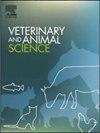Effects of administering the maternal bovine appeasing substance on growth performance, cortisol level and carcass characteristics of finishing feedlot cattle
IF 1.9
Q2 AGRICULTURE, DAIRY & ANIMAL SCIENCE
引用次数: 0
Abstract
This experiment evaluated physiological and performance responses of feedlot steers administered the maternal bovine appeasing substance (mBAS) during the finishing period (day 0 to 178). Steers used in this experiment were the same used to evaluate mBAS during the receiving period whose results have been published (Pickett et al., 2024). After the receiving period, steers were fed a growing diet for 65 days before the finishing period (without mBAS administration). On day 0, steers were assigned to topical administration (10 mL) of: 1) mineral oil on day 0 and 88 (CON), or 2) mBAS on day 0 and 88. Steers that were administered mBAS during the receiving period were also administered mBAS during the finishing period, and the same process applied to CON steers. Cortisol concentrations were measured in tail-switch hair on days 0 and 15. Steers received a growth-promoting reimplant on day 88. Total cattle used since the receiving period was 120 Angus steers, which were assigned in 10 drylot pens (12 steers/pen, 5 pens/treatment). Steers were slaughtered on day 179, and carcass variables were measured. Feed intake did not differ (P = 0.57) between treatments, but average daily gain was increased by 5.6 % (P < 0.04) in mBAS steers, improving their gain:feed by 7.6 % (P < 0.01). No treatment effects were noted (P ≥ 0.24) for carcass weight and variables. Collectively, mBAS administration to feedlot steers at the beginning of the finishing period and at reimplant improved growth rates without altering feed intake, suggesting the use of mBAS to promote productive efficiency of feedlot systems.
饲喂母牛安抚物质对育肥场牛生长性能、皮质醇水平和胴体性状的影响
本试验评价了饲喂母牛安抚物质(mBAS)的饲用阉牛在育肥期(第0 ~ 178天)的生理和生产性能反应。本实验中使用的指标与在接收期间评估mba的指标相同,其结果已发表(Pickett et al., 2024)。接受期结束后,在育肥期前饲喂生长饲粮65 d(不饲喂mBAS)。在第0天,阉牛被分配局部给药(10 mL): 1)矿物油(第0天和第88天),或2)mBAS(第0天和第88天)。在接收期间接受了mba管理的舵手在结束期间也接受了mba管理,同样的过程也适用于CON舵手。在第0天和第15天测量开关尾毛的皮质醇浓度。Steers在第88天接受了促进生长的重新植入。自接收期以来,共使用了120头安格斯阉牛,分配在10个旱地围栏中(12头/围栏,5个围栏/处理)。第179天屠宰肉牛,测量胴体变量。各组采食量无显著差异(P = 0.57),但平均日增重提高了5.6% (P <;0.04),使其饲料增重提高7.6% (P <;0.01)。各处理对胴体重和各变量均无显著影响(P≥0.24)。综上所述,在育肥期开始和重新种植时对饲养场饲主施用mBAS可在不改变采食量的情况下提高生长速度,这表明使用mBAS可提高饲养场系统的生产效率。
本文章由计算机程序翻译,如有差异,请以英文原文为准。
求助全文
约1分钟内获得全文
求助全文
来源期刊

Veterinary and Animal Science
Veterinary-Veterinary (all)
CiteScore
3.50
自引率
0.00%
发文量
43
审稿时长
47 days
 求助内容:
求助内容: 应助结果提醒方式:
应助结果提醒方式:


